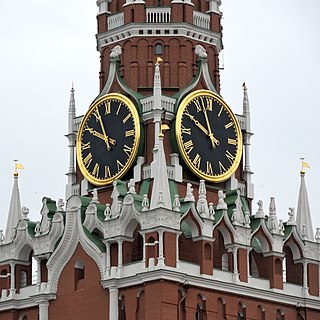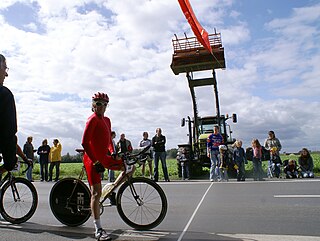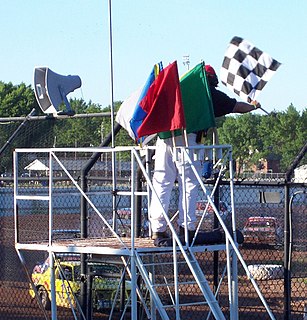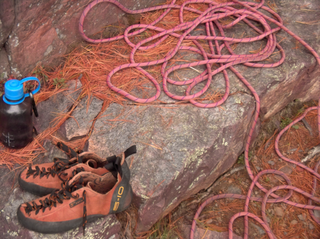
A clock is an instrument used to measure, keep, and indicate time. The clock is one of the oldest human inventions, meeting the need to measure intervals of time shorter than the natural units: the day, the lunar month, and the year. Devices operating on several physical processes have been used over the millennia.

Keirin – literally "racing cycle" – is a form of motor-paced cycle racing in which track cyclists sprint for victory following a speed-controlled start behind a motorized or non-motorized pacer. It was developed in Japan around 1948 for gambling purposes and became an official event at the 2000 Olympics in Sydney, Australia.

A triathlon is a multisport race with three continuous and sequential endurance races. The word is of Greek origin, from τρεῖς or treis (three) and ἆθλος or athlos (competition).

Yachting refers to the use of recreational boats and ships called yachts for sporting purposes. Yachts are distinguished from working ships mainly by their leisure purpose.

Adventure racing is typically a multi-disciplinary team sport involving navigation over an unmarked wilderness course with races extending anywhere from two hours up to two weeks in length. (What Is Adventure Racing Video) Some races offer solo competition as well. The principal disciplines in adventure racing include trekking, mountain biking, and paddling although races can incorporate a multitude of other disciplines including climbing, abseiling, horse riding, skiing and white water rafting. Teams generally vary in gender mix and in size from two to five competitors, however the premier format is considered to be mixed gender teams of four racers. There is typically no suspension of the clock during races, irrespective of length; elapsed competition time runs concurrently with real time, and competitors must choose if or when to rest.

Street luge is an extreme gravity-powered activity that involves riding a street luge board down a paved road or course. Street luge is also known as land luge or road luge. Like skateboarding, street luge is often done for sport and for recreation.
Dirt track racing is a form of motorsport held on clay or dirt surfaced oval race tracks often used for thoroughbred horse racing. Dirt track racing started in the United States before World War I and became widespread during the 1920s and 1930s using both automobiles and motorcycles. Two different types of race cars dominated—open wheel racers in the Northeast and West and stock cars in the South. While open wheel race cars are purpose-built racing vehicles, stock cars can be either purpose-built race cars or street vehicles that have been modified to varying degrees.
Handicapping, in sport and games, is the practice of assigning advantage through scoring compensation or other advantage given to different contestants to equalize the chances of winning. The word also applies to the various methods by which the advantage is calculated. In principle, a more experienced participant is disadvantaged, or a less experienced or capable participant is advantaged, in order to make it possible for the less experienced participant to win whilst maintaining fairness. Handicapping is used in scoring many games and competitive sports, including go, shogi, chess, croquet, golf, bowling, polo, basketball, and track and field events. Handicap races are common in clubs which encourage all levels of participants, such as swimming or in cycling clubs and sailing clubs, or which allow participants with a variety of standards of equipment. Often races, contests or tournaments where this practice is competitively employed are known as Handicaps.

In many racing sports an athlete will compete in a time trial against the clock to secure the fastest time. In cycling, for example, a time trial (TT) can be a single track cycling event, or an individual or team time trial on the road, and either or both of the latter may form components of multi-day stage races. In contrast to other types of races, athletes race alone since they are sent out in intervals, as opposed to a mass start.

Road bicycle racing is the cycle sport discipline of road cycling, held on paved roads. Road racing is the most popular professional form of bicycle racing, in terms of numbers of competitors, events and spectators. The two most common competition formats are mass start events, where riders start simultaneously and race to set finish point; and time trials, where individual riders or teams race a course alone against the clock. Stage races or "tours" take multiple days, and consist of several mass-start or time-trial stages ridden consecutively.

Racing flags are traditionally used in auto racing and similar motorsports to indicate track condition and to communicate important messages to drivers. Typically, the starter, sometimes the grand marshal of a race, waves the flags atop a flag stand near the start/finish line. Track marshals are also stationed at observation posts along the race track in order to communicate both local and course-wide conditions to drivers. Alternatively, some race tracks employ lights to supplement the primary flag at the start/finish line.

A rolling start is one of two modes of initiating or restarting an auto race; the other mode is the standing start. In a rolling start, the cars are ordered on the track and are led on a certain number of laps at a pre-determined safe speed by the safety car.

Fully automatic time is a form of race timing in which the clock is automatically activated by the starting device, and the finish time is either automatically recorded, or timed by analysis of a photo finish. The system is commonly used in track and field as well as athletic performance testing, horse racing, dog racing, bicycle racing, rowing and auto racing. In these fields a photo finish is used. It is also used in competitive swimming, for which the swimmers themselves record a finish time by touching a touchpad at the end of a race. In order to verify the equipment, or in case of failure, a backup system is usually used in addition to FAT.
A muster is an event pertaining to fire/rescue services. It is held in a central area such as a park and has many activities for fire department members and sometimes other community members. A muster typically revolves around a firematic competition between fire companies from around the surrounding area. Other attractions include a flea market, live music, food, demonstrations, apparatus judging, vehicle shows and contests.

The Annual Bay to Bay Trailable Yacht Race is an annual sailing event for monohull and multihull trailable yachts conducted by the Hervey Bay Sailing Club on the first weekend in May each year through the Great Sandy Marine Park and past the Great Sandy National Park and the World Heritage listed Fraser Island. The race is sailed from Tin Can Bay to Hervey Bay through the Tin Can Bay Inlet and the Great Sandy Strait and into Hervey Bay with an overnight stop at Garry's Anchorage between Fraser Island and Stewart Island. The race is Queensland’s largest trailable yacht race and one of the three largest trailable yacht passage races in Australia.
A text display is an electronic alphanumeric display device that is mainly or only capable of showing text, or extremely limited graphic characters. This includes electromechanical split-flap displays, vane displays, and flip-disc displays; all-electronic liquid-crystal displays, incandescent eggcrate displays, LED displays, and vacuum fluorescent displays; and even electric nixie tubes.

Snow boating or snow kayaking is a somewhat newer winter sport typically done by kayakers. It usually involves kayakers descending snow slopes, in contrast to river sports such as whitewater kayaking for which the boats were usually designed. Snow boating is typically done in the backcountry and occasionally at resorts and ski areas. Races are held in a modus similar to those of snowboarding they are known as a boatercross. In the races, kayakers race to a finish line or point.
The conservation and restoration of clocks refers to the care given to a clock to either prevent or resolve issues faced during its life cycle. The variety of materials from which a clock may be constructed and the complexity of clockwork warrant such care to be taken by a clock owner so that a clock can continue to function.
















